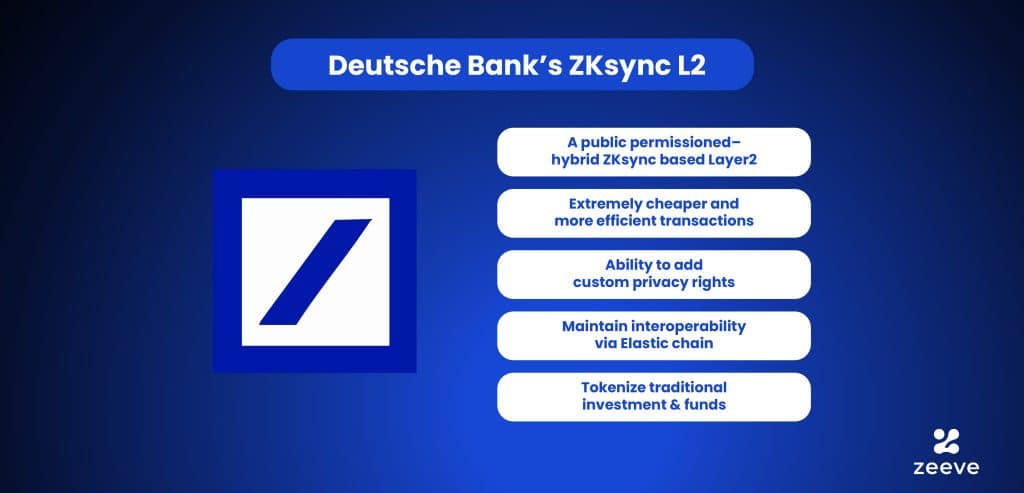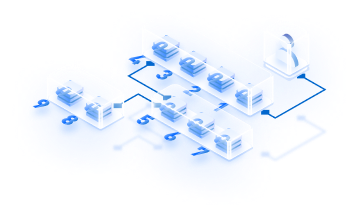Deutsche Bank has captured immense attention with its recent announcement to launch a ZKsync-based L2 to advance its capabilities, streamline end-to-end operations, and tackle compliance hurdles while also enhancing its efficiency by a notable margin. This L2 chain is a part of Dama 2, which is a multi-chain initiative to support seamless asset tokenization for 24+ leading financial institutions.
As we can see, all the speculations related to growth of independent Layer2s are coming true. That’s because the use of blockchain has grown from $4.61B in 2023 to $7.12B in 2024. Bigger names like Goldman Sachs, Circle, J.P. Morgan, and Swedish Central Bank have already adopted blockchain for their business, and now Deutsche Bank has sparked the L2 adoption with its decision.
Layer2 rollups, highly adopted for their permissioned nature, endless flexibility, and dedicated throughput, have the potential to change the way banks and financial institutions work traditionally. Let’s dive deeper and understand why Deutsche is building with ZKsync, how its L2 will drive value, and what it means for other institutions.

A brief about Deutsche Bank and ZKsync
Deutsche Bank is a Germany-based multinational bank and a leader in offering financial services. The banking giant announced in December about building their own Layer2 chain using ZKsync technology. As we talked about, building a Zk-powered chain is a part of Dama 2– a proof-of-concept project that Deutsche Bank and Memento blockchain together spearheaded in November 2024. DAMA (digital assets management access) powers Singapore Monetary Authority and a bunch of mainstream organizations to offer a secure, efficient, and flexible solution for tokenized (digital) fund management and investment services. Dama is essentially a global initiative to simplify asset tokenization for various institutions.
Memento works as the official technology partner for Deutsche Bank, which is launching its L2. In their report, Deutsche Bank said that fees for their services have been provided through Domani– a Memento-owned product designed to issue DEXTF tokens. Note that, Memento itself has built a general-purpose ZKsync Layer2 Hyperchain in collaboration with Zeeve RaaS. Here’s a snapshot:
Zeeve 2024 Wrapped: 🎁 @Memento_Bc : Your Blockchain Autotune 🎶
— Zeeve🔺TOKEN2049 (@0xZeeve) December 30, 2024
This year, we composed a masterpiece with Memento, featuring:
🔹@zkSync L2 Hyperchain: The High-Octane Engine of Scalability ⚡️
🔹@TraceHawk_io by Zeeve: The Guardian of Trust: Your Secure Blockchain Audit 🛡️… pic.twitter.com/s7RCdPwNyY
Speaking about ZKsync technology, it offers a next-gen Layer2 scaling solution for faster and cheaper transaction processing through an off-chain mechanism. For enterprises seeking to build a standalone chain, ZKsync offers ZK stack— a modular, developer-friendly framework to build, customize, and deploy high-performance, fully interoperable L2s. Now, let’s move forward and learn more about Deutsche Bank and its bold move to enter Layer2 paradigm.
Why a Zksync-based Layer2?
Deutsche Bank’s decision to launch an independent ZKsync-powered chain comes from their prolonged interest in blockchain, cryptography, and next-level craze for asset tokenization. However, the initial inspiration for Layer2 is the critical need to fix the regulatory issues that banking institutions face on a public chain–for example, transacting with sanctioned entities or criminals. Coindesk’s interview with Matter Labs’s BD head– Omar Azhar, stated that Deutsche Bank could not be operated with a fully permissioned chain while they also wanted to overcome the challenges of a public chain.
.@DeutscheBank, in collaboration with @Memento_Bc, demonstrates how institutions can use L2s to securely & efficiently manage next-gen financial products.
— ZKsync (∎, ∆) (@zksync) December 18, 2024
→ Tokenized traditional investment funds
→ Digital native funds
→ Hybrid funds that combine both
Powered by @ZKsync https://t.co/AJ9QLkCwg0 pic.twitter.com/z48lJJgHcS
For a strategic solution, Deutsche Bank came up with the decision to build a ‘Public Permissioned’ Layer2 chain. This means anyone can see what’s actually happening on the chain (e.g., accounts being created or tokenized financial assets being transferred), but only authorized parties can access the network to perform certain activities. In simple words, ZKsync is enabling Deutsche Bank to leverage a hybrid L2 chain to match their requirements. Additionally, here are the top reasons why Deutsche Bank has opted for ZKsync:
- Implement the hybrid element in their Layer- ZKsync is one of the leading ZK rollup stacks that allow for creation of a hybrid Layer2 chain, and that’s what Deutsche Bank was looking for. Financial institutions, especially banks, cannot operate in a fully permissioned way, but they also can’t afford to put security at risk with a public chain.
- Extremely cheaper plus more efficient transactions- Higher TPS and low-cost transactions are the main USPs of ZKsync and its 2025 roadmap, ZKsync is targeting 10K TPS with extremely low fees of $0.001. Because Deutsche Bank is aiming to roll out its L2 in 2025, its chain will benefit from these upgraded offerings.
- Add custom privacy rights- ZK chains building with ZKsync have various options to achieve unparalleled privacy, including the flexibility to build in validium mode, integrate privacy protocols like Tornado or Aztec, or go for hosted rollups. However, Deutsche Bank is currently using ZKsync to add ‘super admin rights’ to monitor all the funds and their movement across the network.
- Maintain interoperability with other banks- The concept of ZK Elastic chain has enabled native interoperability to all the autonomous ZK chains at the protocol level. This will allow Deutsche Bank to operate as a hub while also interacting with other financial networks in the ecosystem.
- Tokenize traditional investment & funds- As discussed, Deutsche Bank is part of MAS Project Guardian. Hence, their focus is much on tokenization. Building with ZKsync will allow Deutsche Bank to fully tokenize traditional investment funds, including native digital funds, hybrid funds, and more.

Is it a wake-up call for other institutions?
Now that top-rated banks like Deutsche bank are shifting towards custom Layer2s, it’s a heads-up for all levels of enterprises to start analyzing their requirements and explore the extreme opportunities that Layer2s offers. Because this post is dedicated to Deutsche Bank and its decision to choose ZKsync L2 chain, let’s focus on Zksync and discuss its key features that institutions must consider:
- Highly matured & battle-tested- ZKsync works with the motto– ‘secured by math’, and therefore, transactions of Zk chains are verified on Ethereum completely through the power of zero-knowledge proofs. These proofs implemented battle-tested mathematical techniques to ensure a chain’s state cannot be corrupted due to invalid transactions. As of now, Zksync has invested more than $7 Million in security audits, which allows it to handle 30 Million monthly transactions, 350k+ daily active addresses, and a network of 30+ modular chains.
- Tailored to specific needs- ZKsync offers ZK Stack– a modular framework to enable full autonomy for endless customization of L2 chain to match your project or product-specific requirements. From DeFi, TradFi, NFT (RWA), Gaming, DePIN, or Identity— ZKsync is optimized to support L2 development for a wide range of use cases.
- Infinite scaling- Scaling is the key concept that drives force behind Layer2 rollup, but ZKsync is taking this to another level with the power of horizontal scaling. Similar to the concept of adding more and more servers to the internet, an endless number of ZK chains can be created and added to ZKsync ecosystem at a minimal cost and less hassle. It offers:
- Flat fees despite the gas price
- Default privacy
- Cheaper oracles
- Validium accounts for ultra-low-cost processing
- Native Account Abstraction for impressive UX.
- Unified liquidity & interoperability- ZKsync Elastic chain offers friction interoperability, allowing ZK chains to freely move assets, share information, and tap into unified liquidity enabled through natively interconnected chains.
What can possibly obstruct them?
For institutions, especially the ones in banks & financial, the decision to build a Layer2 rollup is just the first step in leveraging the tremendous benefit of Layer2s. Further, there can be many obstructions in the way of running & managing a permissioned chain. Here’s a brief analysis.
- Lack of specialized consultation- There are multiple rollup frameworks available to build custom L2 chains. Deciding which is a suitable fit for your project can be challenging. Even when you’re sure about using ZKsync, a protocol-level consultation is required to identify the exact requirements.
- Engineering-related issues- Building an L2 rollup chain like ZK Stack chain requires you to fulfill certain infrastructure requirements like on-demand scaling, benchmarked setup, proactive infra monitoring, SLAs, alerts, and more.
- Problem to achieve full modularity- While ZK stack supports 100% modularity, building a modular L2 may require great expertise to analyze 3rd party services like a decentralized sequencer, a different wallet, custom explorer, bridges, and more. Again, doing this on your own is a hassle.
- Complexity in sophisticated solutions- If you’re building L2 for a highly sophisticated solution, analyzing its technician and functional aspects and then building a custom chain is a little tricky and time-consuming at the same time. For example, an advanced gaming project or a DePIN chain.
Is your institution L2 ready? Build with Zeeve RaaS
Zeeve RaaS has designed its ZKSync-specific offering to assist all kinds of projects, from big enterprises to startups and scale-ups. Zeeve RaaS offers top benefits like low-cost deployment and rapid L2 launch. Heavy lifting related to your chain, like mainnet launch, 3rd party service integrations, or infrastructure monitoring & management— each will be handled on Zeeve’s end.
Also, the 1-click sandbox tool at Zeeve RaaS allows you to set up a fully-functional ZKsync testnet in minutes. Further, you will get hands-on assistance for public testnet/ mainnet deployment and ongoing maintenance. Zeeve RaaS has added support for 40+ integration services, and it natively offers all the essential rollup components like sequencers, block explorers, faucets, bridges, wallets, and more.
For more information about Zeeve RaaS and its ZKsync offerings, connect with our experts. Send your queries via mail or schedule a one-to-one call for a free demo.





